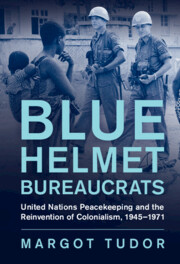Book contents
- Blue Helmet Bureaucrats
- Human Rights in History
- Blue Helmet Bureaucrats
- Copyright page
- Contents
- Figures
- Acknowledgements
- Notes on the Text
- Initialisms/Acronyms
- Introduction
- 1 Testing the Waters, 1945–1955
- 2 Reckoning with Suez, 1956–1959
- 3 Imperial Aspirations, 1960–1961
- 4 Obstructing Self-Determination, 1962–1963
- 5 From Stagnation to Insignificance, 1964–1971
- Conclusion
- References
- Index
1 - Testing the Waters, 1945–1955
Published online by Cambridge University Press: 20 April 2023
- Blue Helmet Bureaucrats
- Human Rights in History
- Blue Helmet Bureaucrats
- Copyright page
- Contents
- Figures
- Acknowledgements
- Notes on the Text
- Initialisms/Acronyms
- Introduction
- 1 Testing the Waters, 1945–1955
- 2 Reckoning with Suez, 1956–1959
- 3 Imperial Aspirations, 1960–1961
- 4 Obstructing Self-Determination, 1962–1963
- 5 From Stagnation to Insignificance, 1964–1971
- Conclusion
- References
- Index
Summary
How did the concept of an international military become a popular diplomatic option in the twentieth century? Chapter 1 establishes how international organisations, such as the League of Nations and the UN, disrupted the state monopoly on war thus helping to pave the way towards the armed peacekeeping project. It traces post-war debates on the UN’s role in nuclear disarmament and examines the UN leadership’s experiments in intervening directly in conflict contexts. Inspired by the UN’s observer presence in the Israel/Palestine conflict, the first secretary-general, Trygve Lie, proposed the creation of a UN Guard to protect the organisation’s field-based staff. Although the UN Guard failed to achieve meaningful diplomatic support, the idea of an international force - organised, trained, and uniformed by the UN - demonstrated the UN leadership’s aspirations for the organisation to shift into militarism. The chapter concludes by examining the diplomatic negotiations and logistical construction of the UN Command in Korea, examining how the UN leadership’s efforts to involve the organisation in the field were limited during this period by US hegemony and logistical superiority.
Keywords
Information
- Type
- Chapter
- Information
- Blue Helmet BureaucratsUnited Nations Peacekeeping and the Reinvention of Colonialism, 1945–1971, pp. 30 - 76Publisher: Cambridge University PressPrint publication year: 2023
